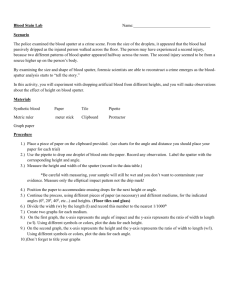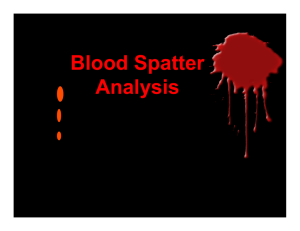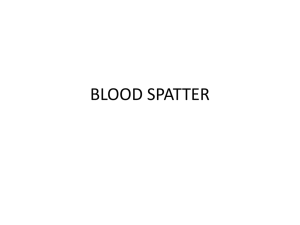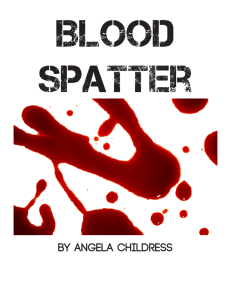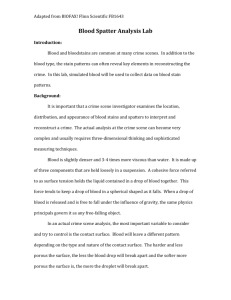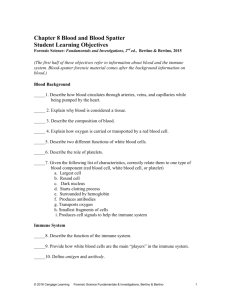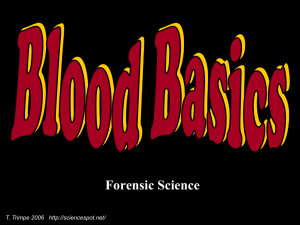Objective Sheet Blood Splatter
advertisement
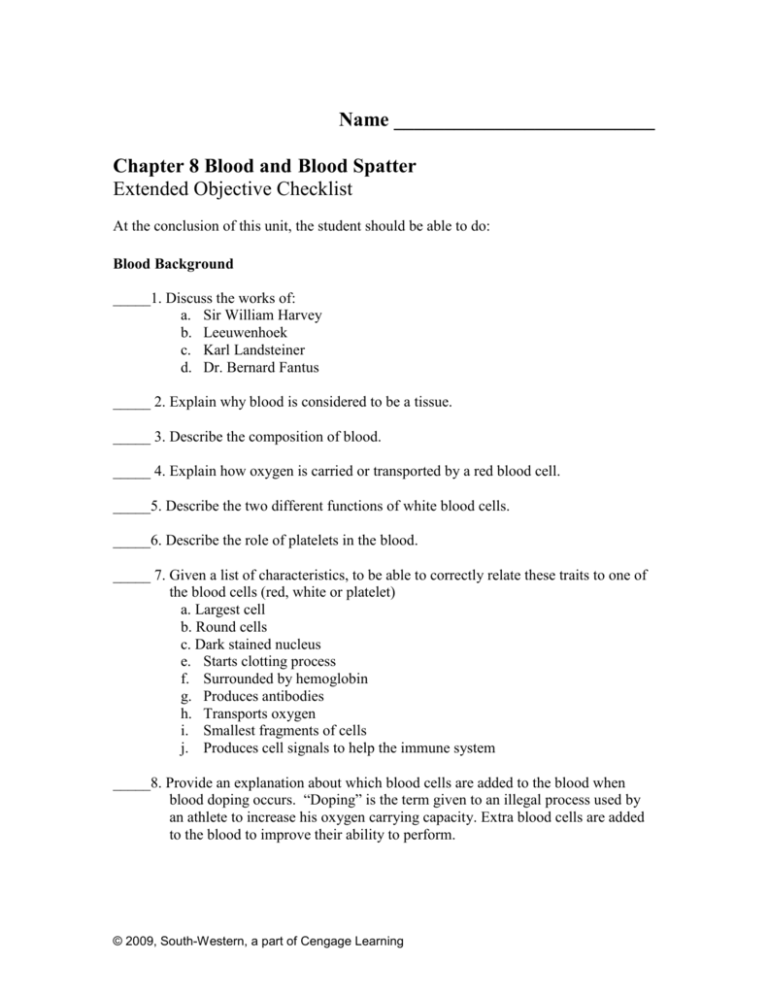
Name __________________________ Chapter 8 Blood and Blood Spatter Extended Objective Checklist At the conclusion of this unit, the student should be able to do: Blood Background _____1. Discuss the works of: a. Sir William Harvey b. Leeuwenhoek c. Karl Landsteiner d. Dr. Bernard Fantus _____ 2. Explain why blood is considered to be a tissue. _____ 3. Describe the composition of blood. _____ 4. Explain how oxygen is carried or transported by a red blood cell. _____5. Describe the two different functions of white blood cells. _____6. Describe the role of platelets in the blood. _____ 7. Given a list of characteristics, to be able to correctly relate these traits to one of the blood cells (red, white or platelet) a. Largest cell b. Round cells c. Dark stained nucleus e. Starts clotting process f. Surrounded by hemoglobin g. Produces antibodies h. Transports oxygen i. Smallest fragments of cells j. Produces cell signals to help the immune system _____8. Provide an explanation about which blood cells are added to the blood when blood doping occurs. “Doping” is the term given to an illegal process used by an athlete to increase his oxygen carrying capacity. Extra blood cells are added to the blood to improve their ability to perform. © 2009, South-Western, a part of Cengage Learning Immune System _____9. Describe the function of the immune system _____10. Provide specific examples of how the white blood cells are the main “players” in the immune system. _____ 11. Define antigen and antibody _____ 12. List characteristics of antibodies: a. What cells produce antibodies? b. When are antibodies produced? c. Of what type of organic compound are they composed? d. Will any antibody work on any antigen? Why or why not? e. Draw a sketch of an antibody f. Label the part of the antibody that is specific to an antigen g. Beside having been sick with a virus or bacteria, how else could someone buildup antibodies _____ 13. Compare and contrast antigens and antibodies. _____ 14. Describe an antigen-antibody reaction and explain how an antibody identifies the antigen. _____ 15. Describe the effect of antibodies on an antigen. Blood Types _____ 16. List the three different proteins found on red blood cells. _____ 17. Distinguish between the following blood types: a. b. c. d. e. f. g. AO+ BOAB+ O+ OAABB+ _____ 18.Draw a sketch of a red blood cell from someone who has the following blood types: a. A+ b. B- c. AB+ d. O_____ 19. Describe how to determine someone’s blood type. © 2009, South-Western, a part of Cengage Learning _____ 20. Analyze the results of blood typing to determine someone’s blood type. _____ 21. Explain why blood types provide class evidence and not individual evidence. _____ 22. Explain why does giving someone the wrong blood type result in an antigenantibody reaction? Include in your answer the term agglutination. _____ 23. Given the blood type of the donor and the blood type of a receiver, Determine if a blood transfusion will be accepted or rejected. _____ 24. Given the individual probabilities of having different proteins in the blood, be able to calculate the probability of having a specific blood type consisting of several different blood proteins. _____ 25. Given the blood type of the donor and the blood type of the receiver, determine if a blood transfusion will be accepted or rejected. Blood Spatter _____ 26. Discuss the history of blood spatter analysis _____ 27. Distinguish between spikes and satellites on blood spatter. _____ 28. Distinguish between blood spatter based upon blood dropping onto a smooth surface and a rough or textured surface. _____ 29. Distinguish between the terms cohesion and adhesion. _____ 30. Using the terms cohesion and gravity, explain why a drop of blood will be circular in appearance as it drops. _____ 31. Using the terms cohesion and surface tension, explain why blood will appear as a rounded surface when it lands on flat surface. _____ 32. Using the terms momentum and cohesion, explain why most of the blood will remain as a drop when it strikes a surface, but some of the blood will continue to move forming an elongated tail. _____ 33. Given a series of blood spatter stains; be able to determine the direction that the blood was moving. Include in your answer the terms satellite blood spatter. _____34. Distinguish the difference between the following terms: a. Cast off blood patterns. b. Transfer blood patterns. c. Projected blood patterns. © 2009, South-Western, a part of Cengage Learning _____ 35.Explain the blood spatter pattern generated from a damaged artery. (arterial gush) Include in your answer the following: a. The over-all pattern of the blood spray b. The reason for the pattern showing high points and low points. _____ 36. Explain why blood spatter looks different when dropped from a height of 30 cm compared to blood dropped from a height of 100 cm. _____37. Describe the difference in a blood spatter pattern if blood was dropped from a height of 30 cm or 100 cm. _____ 38. Define the term terminal velocity. _____ 39. Explain the relationship of terminal velocity to the size of a droplet of blood as it is dropped from different heights ranging from 50 to 100 to 300 cm. _____ 40. Given two blood spatter patterns, to be able to distinguish a difference between blood spatter stains if the source of the blood was coming from a high velocity source such as a gun versus the source of blood generated from a blow on the head. _____ 41.Given two blood spatter patterns, to be able to determine which blood spatter came from a gun fired at close range versus a gun fired from a distance. _____ 42.Define lines of convergence in reference to blood spatter _____ 43. Distinguish between lines of convergence and area of convergence. _____ 44. Explain how to draw lines of convergence from several drops of blood in order to determine the area of convergence or source of blood. Include in your answer: a. How to determine the direction or movement of the blood b. Where to begin drawing your line in reference to the main blood droplet and the satellite blood drops. c. How should the line be drawn through the main droplet of bloodstain? d. How far to draw your lines e. How to determine the point of convergence using these lines of convergence. f. How to draw a circle around the point of convergence. _____ 45. Define angle of impact for blood spatter _____ 46. Determine if a blood drop was dropped straight down based upon the shape of the drop at impact. © 2009, South-Western, a part of Cengage Learning _____47. Explain what happens to the shape of a blood spatter as you move from a 10degree impact angle to a 60-degree impact angle. _____ 48. Explain how to use a caliper to measure the length and width and angle of impact of blood spatter to the nearest 1/10 of a millimeter. _____49. Measure droplets of blood to the nearest 1/10 of a millimeter using a caliper. _____ 50. Explain how to calculate the impact angle from a single droplet of blood. Include in your answer: a. What is measured? b. Explain what formula is used to determine the angle of impact _____ 51. Given a several drops of blood, to be able to analyze the crime scene by conducting a blood spatter analysis: a. Determine the direction of motion of the blood b. Determine angle of impact for several drops of blood c. Determine the area of convergence of the blood droplets d. Calculate the point of origin for the blood droplets. _____ 52. Use blood spatter analysis to try to recreate the events of the crime. _____ 53. Examine stab wounds on a victim and describe the nature of the weapon. From a blood spatter pattern, be able to explain each of the following: _____54. How to determine impact angles for each drop of blood by: a. Measuring the length and width of each droplet of blood and b. Using the formula length/width = sine of the impact angle _____ 55. How to determine the point of convergence by a. Drawing lines of convergence. The area where the lines intersect is the point of convergence. b. Measuring the distance from the area of convergence to an individual blood spatter stain. _____ 56. How to determine the height of the source of blood known as the point of origin either by: a. using the tangent function or b. string method _____ 57. How to distinguish between the following terms: c. Lines of convergence d. Point of convergence c. Point of origin © 2009, South-Western, a part of Cengage Learning _____58. Explain how to determine if a suspect “story” agrees with the story presented by the blood spatter patterns. (For example, did the victim hit their head as a result of a fall, or was the victim beaten with a stick?) Chemical Testing of Blood Spatter _____ 59. Discuss tests used to screen for blood _____ 60. Describe how Luminol can help to visualize blood spatter. Include in your answer: a. What is luminol? b. How is it applied? c. What part of the blood reacts with luminol? d. What type of light is needed to view evidence based upon luminol? _____61. Discuss different tests used to confirm the presence of blood. _____ 62. Explain how antibodies are used to confirm blood is human blood and not another animal’s blood. © 2009, South-Western, a part of Cengage Learning


